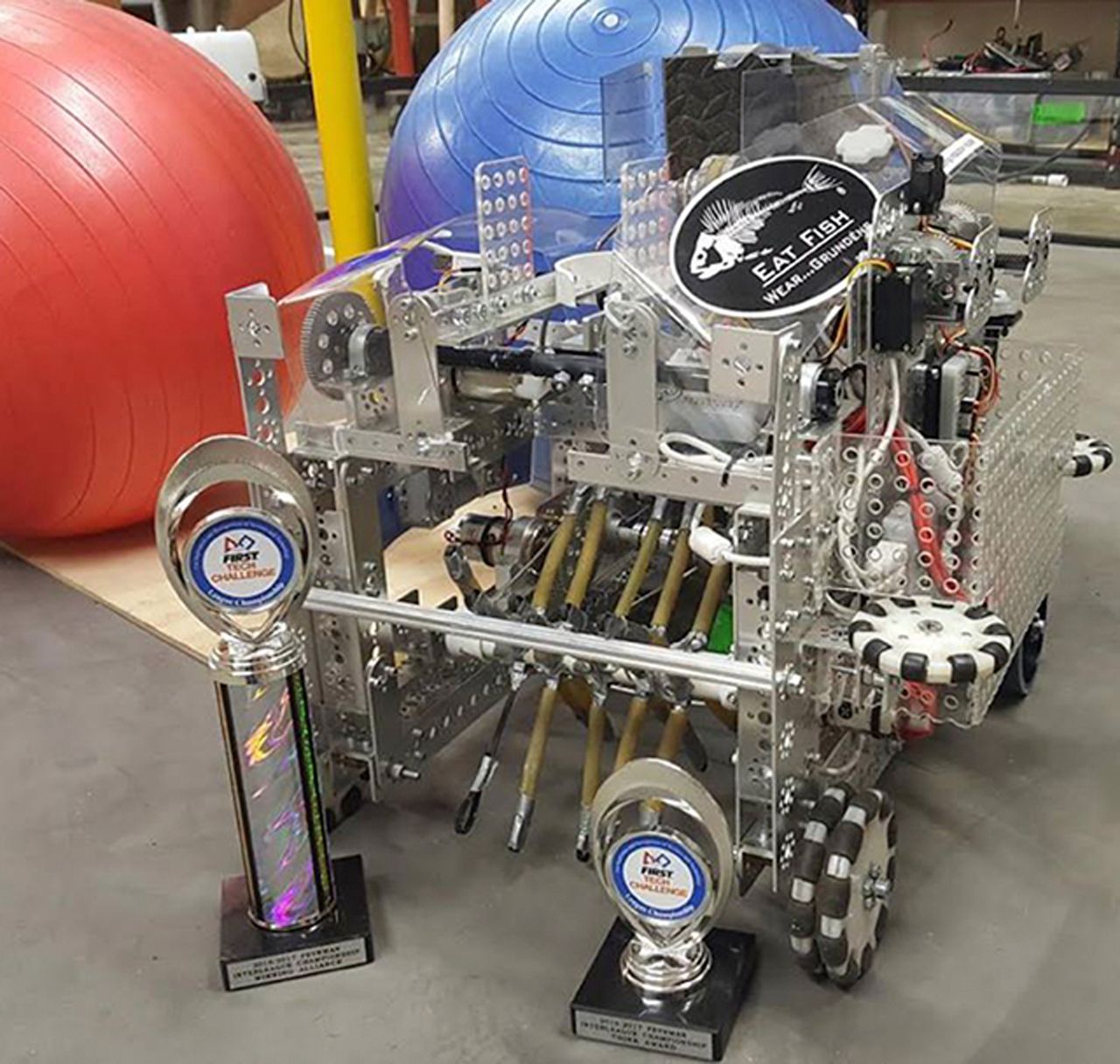The South Beach FIRST Tech Challenge (FTC) Team 1121 — Fishy Business Inc., known in competition circles as the F.B.I., is headed for the first state championship at the ShoWare center in Kent on Feb. 4. The team earned its spot in the competition after racking up an impressive 18-1 win/loss record in three league qualifiers held in the Puget Sound area since November.
The team also won the following awards at league qualifier competitions:
• Inspire Award — Engineering Notebook overall excellence
• Think Award — Engineering Notebook completeness
• Control Award — Tie: Documentation of robot control components
Teams composed of students and adult mentors build game-playing robots they operate in head-to-head challenge. Fishy Business Inc. team members include Ocosta High School seniors Kaylie Prieur, Enapay Croy and Aaron Doull; junior Kaden Smith and freshman Evan Smith. Adult mentors include Steve Wood, Joe Prieur and Arpad Depaszthory.
The program
FIRST — an acronym for ‘For Inspiration and Recognition of Science and Technology’ — was founded in 1989 by Dean Kamen, the inventor of the Segway, an electric, two-wheeled ‘human transporter.’ Kamen, still active in the organization, established the competitions more than 20 years ago to get students interested in science, technology, engineering and math (STEM) and to foster a cultural shift in K-12 education.
By participating in this competition that combines sport with technology, students have access to more than $50 million in scholarships.
The game
Matches are played in an arena that requires robots to complete specific tasks in timed rounds in an alliance with another team.
This season’s game is called “Velocity Vortex” and is played on a 12-foot-square field with approximately foot-high walls and a soft foam mat floor. The field is divided diagonally into a red and a blue side corresponding to the two alliances.
In the center of the field are two goals on a rotatable stand called the Center Vortex. Two ramps, each with a goal, called the Corner Vortex, are placed on opposite sides of the field. There are also four alliance-neutral beacons, two placed on each front wall next to the Corner Vortex. There are floor markings, as well as vision targets placed on the field walls as reference points for robot navigation.
The object of the game is to score points using up to five small balls, called particles, and one large ball, called a cap ball, by moving the cap ball off of the Center Vortex base onto the field floor and scoring particles into their alliance’s Center Vortex or Corner Vortex. Alliances may also gain points by claiming beacons and parking their robot in contact with the Center Vortex base or on the Corner Vortex.
From FRC to FTC
Formed in the fall of 2010, for the past six years, the local 4-H Ocosta Wild Robotocats team has competed in the FIRST Robotics Competition (FRC) at regional, district and international levels with increasingly positive degrees of success. That success includes earning a spot in the world championship competition held in St. Louis in 2015. The Robotocats placed in a highly respectable middle-of-the-pack among more than 100 teams competing from every state in the U.S. and several foreign countries, representing the top 4 percent of 2,900 FRC teams worldwide.
Last season, the FRC team made it to the regionals in Portland.
Fishy Business Inc. is a spin-off from the now inactive FRC team. The reasons for the shift to an FTC model are many:
• While FRC teams include high school students only, FTC teams include students in grades 7-12, making the program more inclusive.
• FRC robots weight up to 120 pounds and are incredibly expensive to tool and fabricate. By comparison, FTC bots are built on a much smaller scale, with each measuring no greater than 18 inches on all sides within its framework — about the size of a microwave oven.
• Other teams in FRC from much more populated areas have much greater access to specialized tools and parts. The need for fabricating parts in the FTC program is much less, saving thousands of dollars.
• Because of their size and increasingly complicated competition capability requirements, FRC bots require many more hours of mentoring, stretching the limited number of mentors available locally beyond reasonable time commitments.
• Regular season FTC competitions are held much closer to home, with all league qualifier events lasting one day, eliminating the need for long travel times and overnight stays.
• Total costs for FRC participation each season ran well over $20,000, not including an additional approximately $25,000 spent to get the team to St. Louis in 2015 to participate in the multiday world championship.
By comparison, costs for this season’s FTC builds and competition participation during the regular season have been about $3,000. Currently the team is financed solely by contributions from the state Office of Public Instruction (OSPI) and Boeing.
If the team qualifies to advance beyond the state competition, additional financing will be necessary. If that’s the case, the team hopes to garner support from local businesses and individuals that have helped offset travel, lodging and meal expenses in the past.
Ten teams will advance from the Feb. 4 state championship competition to the FTC West Super Regionals, which will include teams from 13 different states. That competition will be held in Tacoma on March 11 and 12.



